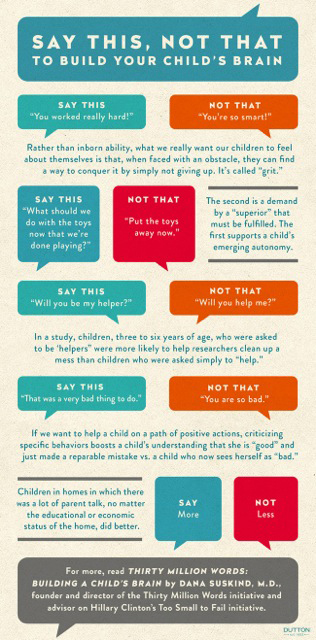Dana Suskind, M.D., Professor of Surgery and Director of the Pediatric Cochlear Implant Program at the University of Chicago, recently presented her findings in the area of child learning and development at a Family Action Network (FAN) program at Skokie School. Her insights and advice are important for all parents and caregivers of young children.
Curiosity and questions are the keys that open the door to insight. Nine years ago, as a surgeon routinely implanting the Cochlear Implant – a device that enables children born deaf to hear and talk – Suskind realized that the technology “came with a large asterisk.”
She explains by telling the story of two of her early patients, Zach and Michelle. Both were born deaf to different hearing parents who desperately longed for their children to live happy, fulfilled lives. “There should have been no difference in their potential to learn language,” says Suskind.
Zach quickly transitioned from hearing to understanding to talking, and by third grade was on grade level in a mainstream classroom. However, Michelle often didn’t seem to understand the meaning of spoken language, and by third grade was in a special education class reading at a kindergarten level.
Suskind began asking questions. What is the difference between them? It turned out that the “asterisk” is the distinction between the worlds into which Zach and Michelle had been born. Michelle’s family struggled with homelessness and with securing basic necessities like food; unlike Zach, she had been born into poverty. The phenomenon of learning differences based on socio-economic status is so prevalent that it’s been given a name: the achievement gap.
But why does income level matter when it comes to a child fulfilling his or her potential? Suskind’s own research and other studies – notably one 50 years earlier by Hart and Risley – revealed that it comes down to language. In poverty-stricken areas, there are fewer verbal affirmations, more prohibitions and less complex vocabulary used. The number of words that are spoken and how they are spoken to children from birth to age 3 are critical factors for school readiness and achievement.
Parent Talk is Important for ALL Children
Words grow a baby’s brain. About 85 percent of a brain’s development happens in the first three years.
“When we’re born, most of our organs are already fully formed and functional. But not the brain,” Suskind explains. “While genetics provide the blueprint for potential, science strongly indicates that reaching it depends upon learning in those early years.” There is no other time as robust or influential.
As a parent, you have the greatest influence over your baby’s brain development. Parent talk is more than just words, it’s the creation of a strong parent/child bond. Diana Mendley Rauner, president of the Ounce of Prevention Fund, a group that applies science to create innovative learning programs, adds, “Behind every word is an enormous amount of power and emotion – even before children are born.”
When it comes to the kinds of talk that have the biggest impact, Suskind recommends using “The Three Ts”:
Tune In
Pay attention to what your child is interested in; look into his or her eyes. Connect with what your baby is interested in.
Talk More
Narrate your baby’s day by discussing things you’re doing like changing her or making dinner. Use a rich vocabulary. Include talk about the past or future.
Take Turns
Though your baby may not yet be able to interact verbally, you can respond to eye contact, gestures, burps, gurgles or follow his gaze. View your child as a conversation partner from day one.
Science as the Basis for Social Change
In addition to her medical duties, Suskind is also the founder and director of the “Thirty Million Words (TMW) Initiative.” The program’s long-term vision is educational equity for all children. They’ve undertaken the enormous task of educating parents-to-be as well as community touch-points like teachers, doctors, faith organizations and government agencies.
Suskind’s recent book “Thirty Million Words: Building a Child’s Brain” is one tool for spreading the message. Among TMW’s initiatives is a multimedia presentation aimed at new mothers in maternity wards, encouraging pediatricians to pair informative videos with baby well-visits and a six-month home visit program that works with parents to set and monitor their own “talk goals.” Every interaction is an opportunity to utilize “The Three Ts.”
TMW is trying to stem the tragic waste of potential. Their programs intend to embed parent talk in our social fabric; they’re aiming for a population-level shift.
“It’s too late if we wait to address problems when they appear,” says Suskind.
Rauner’s “Ounce of Prevention Fund” also develops programs to close the achievement gap.
“It’s a real ‘aha moment’ when a 17-year-old dad sees that his voice turns his newborn’s head in his direction or when a teacher gets on the floor with the children rather than standing at the front of a classroom.” These moments are when real connections are made.
Additionally, the Fund works with community leaders to advocate for investments in early childhood education and lobbies for better parental leave policies and programs for pregnant teens.
“Research shows the cost benefit of such programs. It’s about eventually being able to do this work for 6 million children in poverty,” Rauner says.
Suskind adds, “Investing in all of our children – rather than just our own – is an investment in the future of our country. Let’s allow every child to reach their potential.”
Help spread the word by sharing this article and websites with parents and others in your community.


